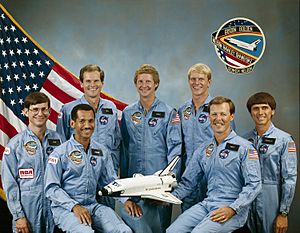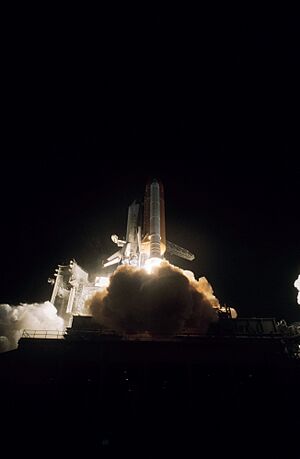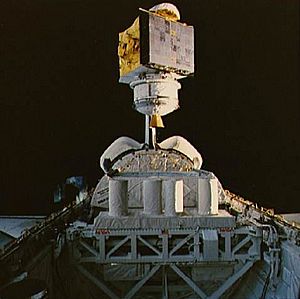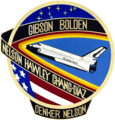Robert J. Cenker facts for kids
Quick facts for kids
Robert J. Cenker
|
|
|---|---|
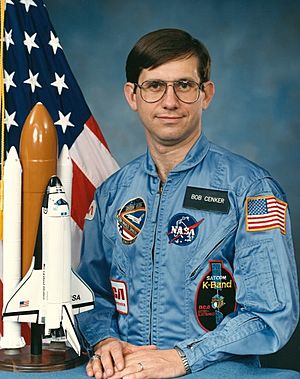 |
|
| Born |
Robert Joseph Cenker
November 5, 1948 Menallen Township, Pennsylvania, U.S.
|
| Status | Retired |
| Nationality | American |
| Alma mater | Penn State, B.S. 1970, M.S. 1973 Rutgers, M.S. 1977 |
| Occupation | Engineer |
| Space career | |
| RCA Astro-Electronics Payload Specialist | |
|
Time in space
|
6d 02h 03m |
| Missions | STS-61-C |
|
Mission insignia
|
|
| Retirement | January 18, 1986 |
Robert Joseph "Bob" Cenker (born November 5, 1948) is an American aerospace and electrical engineer. He is also a consultant for space systems and a former astronaut. Bob Cenker worked for many years on different spacecraft projects. He mostly focused on satellites that help with communication.
In January 1986, Cenker was part of the crew on the twenty-fourth NASA Space Shuttle program mission. This was the seventh flight of the Space Shuttle Columbia, known as mission STS-61-C. Cenker was a Payload Specialist, which meant he was an expert representing his company, RCA Astro-Electronics. This mission was the last one before the terrible Challenger disaster. That accident stopped the Space Shuttle program until 1988. Because of this, Cenker's mission was called "The End of Innocence" for the Shuttle program. After his space flight, Cenker went back to working in the space industry. He has also made many public appearances for NASA.
Becoming an Astronaut: Bob Cenker's Journey
Early Life and Schooling
Bob Cenker was born on November 5, 1948, in Menallen Township, Pennsylvania. He went to Penn State University. There, he earned a bachelor's degree in aerospace engineering in 1970. He continued his studies at Penn State and received a master's degree in aerospace engineering in 1973. Later, in 1977, Cenker earned another master's degree in electrical engineering from Rutgers University.
Working Before Spaceflight
Cenker worked for 18 years at RCA Astro-Electronics and later GE Astro Space. He helped design and test satellites. He also worked on how satellites move and stay in position in orbit. For most of his career, he worked on communications satellites. These satellites help us talk to people and send information around the world.
He was in charge of preparing the Satcom D and E spacecraft for launch. He also made sure that the Spacenet/GStar satellites could work with different launch vehicles, like the Delta, Space Shuttle, and Ariane rockets.
Bob Cenker's Space Mission
How He Became a Payload Specialist
Sometimes, if a company wanted to launch their satellite using the Space Shuttle, NASA would let one of their experts fly along. This expert was called a payload specialist. When RCA decided to launch their Satcom Ku-1 satellite with NASA, Bob Cenker and his co-worker Gerard Magilton were chosen to train for the mission. One of them would go into space with the satellite.
Cenker and Magilton trained with professional astronauts. They also trained with other payload specialists, including those who were going to fly on the next mission, STS-51-L, aboard the Challenger.
The STS-61-C Mission
The flight of Columbia was supposed to happen in August 1985, but it was delayed. In July 1985, the RCA satellite was confirmed for the mission, and Cenker was assigned to fly. The mission was named STS-61-C.
Columbia had several attempts to launch that were stopped. One attempt on January 6, 1986, was very risky. A valve didn't close correctly, causing a problem with the liquid oxygen. The launch was stopped just 31 seconds before lift-off. It was later found that the problems were due to people being tired from working too much.
Another launch attempt three days later, on January 9, was also stopped. The pilot, Charlie Bolden, said that if they had launched, the engine could have exploded. In total, it took a record eight tries to get Columbia into space.
Columbia finally launched on January 12, 1986. There were seven crew members aboard. Besides Cenker, the crew included Robert L. "Hoot" Gibson, Charles F. Bolden, George D. Nelson, Steven A. Hawley, Franklin R. Chang-Diaz, and US Representative Bill Nelson. Cenker and his crew traveled over 2.5 million miles and spent more than 146 hours in space.
During the six-day mission, from January 12 to 18, Cenker did various tests. He also used an infrared camera for an experiment. His main job was to help deploy the RCA Americom's Satcom Ku-1 satellite. This was the main goal of the mission. The satellite was deployed almost 10 hours into the flight. It worked until April 1997. This was the last big commercial satellite launched by the Space Shuttle program.
After the Mission: "The End of Innocence"
Just ten days after Columbia returned, the Challenger Space Shuttle was destroyed. All the astronauts on board were lost. One of them was Greg Jarvis, another civilian payload specialist. Because of this, Commander Gibson later called the STS-61-C mission "The End of Innocence" for the Shuttle program.
The Space Shuttle fleet was stopped until 1988. After missions started again, civilian payload specialists like Cenker were not allowed to fly for a while. The program started again on December 2, 1990. By that time, RCA had been bought by General Electric. Cenker was the only employee from RCA Astro-Electronics to ever fly in space.
The Payload Specialist program has been discussed a lot. Some people wondered if it was right to give limited spaceflight spots to civilians. They worried that these people might not have fully understood the dangers of a Shuttle mission.
Life After Spaceflight
After his space mission, Bob Cenker went back to working in the aerospace field. He worked as a manager for a satellite program. After leaving GE, Cenker became a consultant for different aerospace companies. He advised them on space research, spacecraft design, and how to operate them in space.
He helped with many satellite projects, including small satellites and military communication satellites. He also helped evaluate launch vehicles for companies like Motorola and Intelsat.
In 2017, Cenker's STS-61C crewmate, former US Senator Bill Nelson, spoke in the US House of Representatives. He talked about the STS-61C mission and mentioned each crew member, including Cenker.
In June 2017, Cenker visited Scotland. He and astronaut Doug Wheelock gave talks to children in schools as part of the Scottish Space School.
Cenker still makes public appearances for NASA. He often visits the Kennedy Space Center Visitor Complex. He was there in March 2017, January 2023, and April 2024.
Celebrating Apollo 11
Around the 50th anniversary of the Apollo 11 mission in 2019, Cenker took part in several public events. He joined other former NASA astronauts to celebrate this historic moon landing.
In an interview, Cenker talked about his education, his work, and his space mission. He also shared his thoughts on why the Apollo 11 mission and space travel are so important. He told students interested in space to study what they love. He said, "I love engineering and even if I didn’t make it into space, I would still be doing what I loved."
He also joined two other shuttle astronauts, Bill Shepherd and Charlie Camarda, at a "Moon Fest" event in New York. This event celebrated the 50th anniversary of the Apollo 11 landing.
Personal Life and Beliefs
Bob Cenker is married to Barbara Ann Cenker. They have two sons and a daughter.
In an interview, Cenker said he believes humans naturally want to explore. He also talked about his religious beliefs. He said that going into space made his beliefs even stronger.
Professional Groups
Bob Cenker is a member of several important professional groups:
- Associate Fellow in the American Institute of Aeronautics and Astronautics (AIAA)
- Life Member of the Penn State Alumni Association
- Life Member of the Association of Space Explorers
- Registered Professional Engineer in New Jersey
- Senior Member of the Institute of Electrical and Electronics Engineers (IEEE)
- Sigma Gamma Tau
- Tau Beta Pi
See also
- 1986 in spaceflight
- List of human spaceflights
- List of Space Shuttle missions
- List of Space Shuttle crews
- List of Shuttle payload specialists
Images for kids


